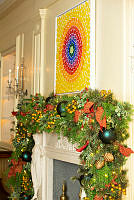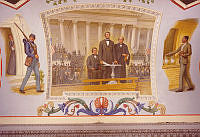Rubenstein Center Scholarship
The Enslaved Household of Tench Ringgold
This article is part of the Slavery in the President’s Neighborhood initiative. Explore the Timeline
From 1818 to 1831, Tench Ringgold served as U.S. Marshal for the District of Columbia. His home (today known as the DACOR Bacon House) sits on the corner of F and 18th Streets, about three blocks from the White House. Built in 1825, the house is a notable example of Federal-style architecture.1 Tench Ringgold came from an old Maryland merchant and slave-owning family, originally from the Eastern Shore. At the end of the eighteenth century, they took possession of a large estate in Washington County outside Hagerstown, Maryland on which they built an imposing house they called Fountain Rock . In 1796, when he was twenty years old, Ringgold settled in Georgetown and opened a warehouse to ship goods by river.2 He soon married Mary Christian Lee, the daughter of the wealthy and politically notable family of Thomas Sim Lee, former Maryland governor and politician, who also owned a large plantation near Frederick and more than 200 enslaved men, women, and children. Thus Ringgold joined a number of well-connected Washingtonians, including the Tayloes, the Masons, the Stodderts, and others in spending part of their time in the new city and part on the country estate.

Ringgold House, now DACOR Bacon House, 1801 F Street. Constructed by Tench Ringgold in 1825. Architect unknown. The house was originally two stories with two or three dependencies.
Public domain.As wealthy planters and merchants on the Eastern Shore, the Ringgolds were accustomed to owning and dealing in slaves. Tax records from 1803 indicate that Tench’s section of the Ringgold estate in Maryland amounted to 1,500 acres and thirty-four enslaved people, while his brother, Samuel Ringgold, later a congressman from Washington County for five terms, owned 15,000 acres and eighteen enslaved people.3 We don’t know much about the activities on Tench’s estate, but the family was well-off and Tench was accustomed to managing and controlling enslaved people.4 However, a failed run for a seat in the Maryland legislature in 1803-04 and his growing family in Washington led him to focus more on his endeavors in the capital city, while leasing and offering to sell the property in Maryland. In 1810, he asked a prominent lawyer in Georgetown, Philip Barton Key, uncle of Francis Scott Key, for a loan of $2,000, and pledged eighteen of his enslaved people in mortgage as collateral for the loan. This arrangement allowed him to purchase land and commission architect George Hadfield to build a ropewalk in the area of the Navy Yard on the Eastern Branch (today’s Anacostia River). The ropewalk, a working site where rope was manufactured for sale to the new U.S. Navy, was one of several enterprises for which Tench was known before he was appointed U.S. marshal.5 He also may have used part of the loan to begin the construction of his first house in the city of Washington, a now-lost mansion built on the corner of 25th and L Streets.6
The 1820 census of the Ringgold household listed some twenty-nine people, eighteen of whom were enslaved men, women, and children. We know the names of the Ringgold family from genealogical histories and historical texts, but the census did not provide the names or identities of the enslaved individuals or their occupations.7 Some of the enslaved people were likely brought from Maryland to work in Ringgold’s house and in his newly established enterprises. In 1807, he leased the Maryland property and held a “public auction” to sell off some of his enslaved farmhands and their children. Those who were not sold may have been included in the mortgage agreement he made with Key in 1810, which he was able to pay off in the allotted time. Sometime before 1817, Ringgold sold Stephen, John, Paul and his wife and two of their children, Barnet and Polly to John K. Smith. In 1817, Smith sold them to Leonard H. Johns of Georgetown.8 The remaining twelve individuals from the 1810 deed could well have been the core of the working staff that remained with the Ringgolds during their eight-year residency in the new F Street house.

Petition for Freedom filed by “Negro Susan” in 1836 on behalf of herself and her four children Kitty, Mary, Maria, and Thomas from Tench Ringgold, then living in Alexandria (Arlington) County, and his daughter Mary [D. G.] Ringgold. Their lawyer was Francis Scott Key.
National Archives and Records Administration, Record Group 21, Entry 6, Box 561, Folder 399: http://earlywashingtondc.org/doc/oscys.case.0208.001Of these twelve people, we know the last name of only one – Monica Brown. In March 1814, Monica was thirty years old, when Mary Christian Lee Ringgold, Tench’s wife and mother of his five children, died. After Mary’s death, Ringgold freed Monica. The manumission paper, now preserved in the property records of the District of Columbia Archives, states that Ringgold freed “the Negro woman Monica Brown after expiration of three years from this date, or the date of my death if I should die before the expiration of three years” and that she “is able to work and gain a livelihood and maintenance.”9 The dates of Mrs. Ringgold’s death and Monica’s manumission suggest that Ringgold granted her freedom in appreciation for the care she had given Mrs. Ringgold during her final illness. After she was freed in 1817, Monica disappears from the historical record. She may have remained in the District under a different name or she may have returned to Washington County where her family may have been located.
Betsy was another enslaved member of the staff. In 1806, Betsy was given to Mrs. Ringgold by her father, Thomas Sim Lee. Betsy may have come from Frederick County or Georgetown before she was sent to the Ringgolds. Lee owned a large plantation in Frederick County called Needwood Forest and around 1792 he built a large house in Georgetown on the corner of what is now M and 30th Streets. The building still stands today.10 However, he sold the house in 1803 and after the death of his wife in 1805, moved back to Needwood where he remained until his death in 1819.11 It is possible that Betsy was part of the household in Georgetown and then given to Mary Christian Lee Ringgold when Lee departed from Washington. In 1822, Betsy gave birth to a daughter named Louisa, so she likely would have been a young woman when she was gifted to the Ringgold household. Louisa next emerges in the written record in 1862, when Mary D.G. Ringgold, Tench’s eldest daughter, sought compensation for Louisa’s services through D.C.’s compensated emancipation. The petition mentions her age, origins, features, and skills. Mary described Louisa as a “bright mulatto, about five feet high, straight black hair, dark eyes, small regular features, and inclined to fullness.” She was an expert lady’s maid, cook, and seamstress, and in later years was hired out by Miss Ringgold to work for $8.00 a month. In 1844, Louisa gave birth to a daughter named Elizabeth, and she too worked in the Ringgold house and was trained as a cook and seamstress. When Elizabeth was hired out, Mary Ringgold collected $6.00 a month for her labor.12 Thus three generations of an enslaved family were forced to labor in the Ringgold household. After Louisa and Elizabeth were emancipated, they disappear from the written record.

Petition for Compensation for Louisa, formerly enslaved daughter of Betty, who had been given to Tench Ringgold in 1806 by his father-in-law, Thomas Sim Lee, former governor of Maryland and one of the state’s largest slave holders. Compensation of $2,000 for Louisa and her daughter Elizabeth was sought by Tench’s daughter, Mary D. G. Ringgold.
Civil War Washington: http://civilwardc.org/texts/petitions/cww.00450.htmlSome of the other enslaved individuals may have constructed and maintained the Ringgold’s home. When Tench Ringgold decided to build a brick house on the corner of F and 18th Streets in 1825, he certainly used some of his enslaved men to provide construction labor. Like many other early Federal-style houses built in Washington, enslaved laborers would have prepared the foundations, made and laid the bricks, assisted with or carried out the needed carpentry, and helped complete the interior.13 The architect of the house is unknown, although Ringgold worked with both Benjamin Henry Latrobe and James Hoban in his capacity as one of three commissioners selected by President James Madison to oversee the reconstruction of the city after the British burned Washington in 1814.14 Ringgold worked with Latrobe to oversee the rebuilding of the Capitol, and with Hoban to rebuild the White House and executive offices.15 Ringgold later asked Hoban to submit an estimate for repairing the District of Columbia jail, for which, as U.S. marshal, he was responsible for maintaining.16 Click here to learn more about the enslaved household of President James Madison.
Soon after their house was built in 1825, the Ringgolds began to entertain lavishly other elite Washington families. The year before, the young Charles Francis Adams, son of the Secretary of State and future President John Quincy Adams, had dropped by the Ringgolds’ residence for a party celebrating the New Year.17 In the following years, the household and its workers would also regularly welcome former President James Monroe, who had become a close friend of the Ringgolds.18 Click here to learn more about the enslaved households of President John Quincy Adams. Click here to learn more about the enslaved households of President James Monroe.
In 1829, the house hosted the weddings of two of Ringgold’s daughters: Sarah Brooke Lee Ringgold married lawyer John Moylan Thomas in July; and Anna Maria Ringgold married the well-connected Washington doctor, Henry Huntt, in November.19 This latter gathering was crashed by the young Salmon Chase, who recorded in his letters:
“Nov 17. Dr. Huntt was married this evening to the youngest daughter of Mr. Ringgold. The evening was extremely unpropitious, but a great crowd was there. I went as a looker on. I saw Mr. Van Buren moving about, paying compliments and hunting for good opinions.20 Many beaux promenaded the rooms and many belles dying for their attentions. Mr. R—was bustling about like a an [man] determined that if his guests were not pleased it should be thro no fault of his. The doctor was as happy as an old bachelor just [escaped] from the barren confines single blessedness as apt to be on such occasion and the bride was a very pretty bride. At 10 large folding doors were thrown open displaying to the gourmands of the company a most pleasing spectacle. An instant rush was made toward the tables; yet the gallantry of the gentlemen [obliged?] them to resist until the fairer half of creation had retired. Then however hams, rounds of beef, chicken were not spared. Pyramids of ice were demolished in less time than is required to record their fate. Wine flowed in rivers – and rivers [were] drank dry. At length however the appetite of the most eager was sated and as there was nothing more to be seen I returned home.”21
For these occasions, the enslaved staff of the Ringgold household must have been busy with the hams, chickens, and rounds of beef, to say nothing of the pyramids of ice. The feast may have been prepared by the enslaved cooks, but it is also possible that Ringgold hired a professional chef, perhaps someone like Henry Orr (d. 1836), the highly-respected free African American who was often employed by the Washington elite to cater their important dinners.22
In carrying out his duties as U.S. marshal, Ringgold often traveled from his house to his office at the Circuit Court on Capitol Hill and to various courts within the jurisdiction of the city of Washington, including the one in Alexandria. Tax books of 1825 show that Ringgold owned a carriage and a carry-all. The carry-all was a smaller carriage drawn by a single horse for daily errands. The carriage likely required one or two coachmen as Ringgold made his appointed rounds. The house on F Street included a large garden and possibly three dependencies, including a stable to house the carriage and several of the enslaved men who worked as coachmen or in the house and a kitchen, where most of the enslaved female workers would have worked and slept.23 A third structure, in the northwest corner of the garden, could have been an ice house.
Ringgold was in debt most of his working life. In order to build the F Street house, he borrowed $6,000 from his daughter Sarah. Her money likely came from properties she received from the estate of her grandfather, Governor Lee. The loan was registered in the courts in 1825 and fell due after five years.24 When he failed to repay the debt by 1831, the year he lost his job as marshal, he made arrangements to forestall the repayment and took in five Supreme Court justices as paying lodgers for the 1831 and 1832 court terms, including Chief Justice John Marshall. It was Marshall’s inclination to house the justices altogether in order to promote collegiality among them, and records suggest their stay at the Ringgold household was comfortable – despite its distance from Capitol Hill.

Petition for Compensation for Louisa, formerly enslaved daughter of Betty, who had been given to Tench Ringgold in 1806 by his father-in-law, Thomas Sim Lee, former governor of Maryland and one of the state’s largest slave holders. Compensation of $2,000 for Louisa and her daughter Elizabeth was sought by Tench’s daughter, Mary D. G. Ringgold.
Civil War Washington: http://civilwardc.org/texts/petitions/cww.00450.htmlEventually the court was obliged to foreclose on Ringgold, and in 1833 the property sold at a public auction to Sarah and her husband, who later resold it. Forced to find new living quarters, Ringgold purchased a 150-acre farm in Alexandria County, Virginia (now Arlington).25 In 1834, he settled on the property with a reduced enslaved staff who farmed this small estate in order to provide a living for Ringgold. According to the 1840 census, only five enslaved workers still lived with him, two of whom were employed in agricultural work.
Susan was among those no longer enslaved in Tench’s household. In 1836, she sued for her freedom and for the freedom of her four children -- Kitty, Mary, Maria and Thomas.26 After receiving no response from either Tench or his daughter Mary, Susan submitted another petition in April 1837. Francis Scott Key served as Susan’s lawyer. Although a slave owner himself, Key brought some one hundred cases before the court for enslaved men and women seeking their freedom.27 Although Key’s arguments are unknown, there may have been several reasons why Susan sought freedom at this point. When Tench moved across the river to Alexandria County, he may have separated her from her children and husband who remained in Washington City; or she may have been able to prove she was able, like Monica Brown before her, to support herself – a requirement of the existing District of Columbia Slavery Code. Ringgold died in 1844, and the inventory of his estate lists no enslaved men, women, or children.28 In all likelihood, they had been given to his heirs, as Louisa and Elizabeth were passed on to Mary Ringgold, or sold privately.

Reward posted by Jesse Brown, owner of Brown’s Indian Priness Hotel, for the return of William H. Ringgold, who claimed to be the son of Tench Ringgold.
(Washington) Daily National Intelligencer, October 22, 1845, p. 3.More research is planned on the enslaved staff of the Ringgold House, most of whom remain sadly unknown. One new path has recently been opened by a reference in the updated biography of Tench Ringgold in Wikipedia – the suggestion that “Thomas H. Ringgold” was his son by an enslaved African-American woman. Further inquiry into the matter revealed that Thomas was originally named William. He was sold to Jesse Brown, owner of the Brown Indian Princess Hotel in Washington, at the age of eight and worked at the hotel until 1845 when he escaped at age twenty-five. Brown posted a “$100 Reward” advertisement in the Daily National Intelligencer seeking William’s capture and return.29 William fled the city via the Underground Railroad and eventually reached Springfield, Massachusetts, where he settled down in a new life. He changed his name to Thomas but kept the middle initial and the surname. Local residents in Chicopee, where he had opened a barber shop, provided him the funds to purchase his freedom, and he traveled back to Washington to receive the emancipation deed in 1851.
Recollections of William’s story (aka Thomas), published thirty years later in the Springfield News and Comment, suggest that he may have been the son of one of Tench’s nephews, a son of General Samuel Ringgold of Washington County, Maryland.30 However, when Thomas remarried in 1857 and was asked to provide the name of his father, he put down “Tench Ringgold.”31 The mystery of his identity remains to be resolved.
In 1835, Ringgold House was sold to Samuel Sprigg, former governor of Maryland (1819-22) who gave it to his daughter, Sally Sprigg who was married to William T. Carroll, Clerk of the Supreme Court. By 1840, the census reveals some twelve enslaved men, women, and children were living and working in the house. Additional research into this new household and its enslaved inhabitants is underway.
This exploration has been part of ongoing research into the history of the DACOR Bacon House as it approaches the 200th anniversary of its construction. Hopefully, new efforts will uncover the contributions made by both owners and workers to the renown of the house.
Terry Walz is an Independent Scholar based in Washington, D.C., author of two books on Egypt, and currently working on a revised history of DACOR Bacon House.





